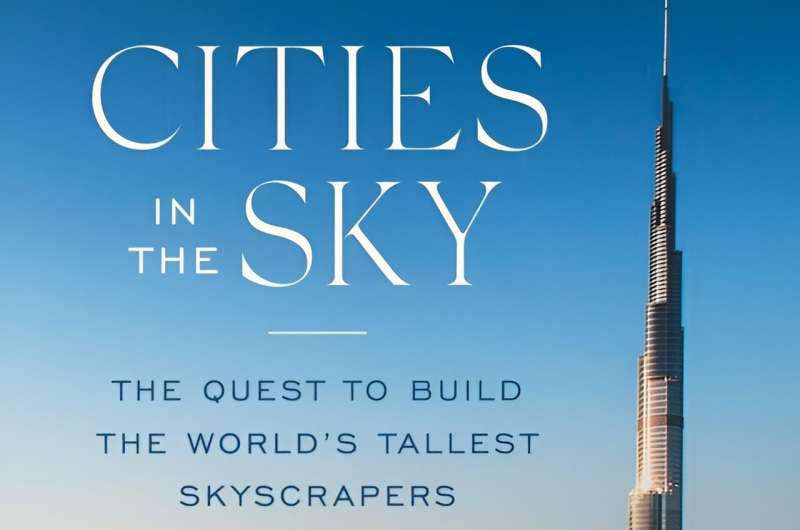This article has been reviewed according to Science X's editorial process and policies. Editors have highlighted the following attributes while ensuring the content's credibility:
fact-checked
trusted source
proofread
Economist explores why skyscrapers keep getting taller and why the world loves them

Rutgers-Newark professor Jason Barr, an authority on skyscrapers, examines them through the lens of an economist, not an expert on architecture.
But if asked, he's quick to name his favorite: The Empire State Building, which for 40 years stood as the world's tallest building after it was erected in 1930, standing at 1,250- feet. It has fascinated Barr since he was a child growing up in Long Island.
"It's just beautiful and elegant. What set it apart from other buildings at the time was its spire, which added to its height,"' says Barr.
He recounts the building's history in his book "Cities in the Sky: The Quest to Build the World's Tallest Skyscraper," which was published by Scribner Books this month.
"Cities in the Sky" does more than document the international competition to build the biggest and best. It explores why skyscrapers became necessary, and why, despite their detractors—who complain they block sunlight and occupy too much vertical space—they continue to be sought-after places for people to live and work.
Much has been written about skyscrapers as architectural gems (or nightmares) and they are often viewed as the embodiment of ego and vanity—phallic symbols built to represent the wealth and power of men who commissioned them.
But Barr says that's the wrong way to look at them. "When we vilify narcissistic developers, we oversimplify and lose awareness in the process—the city is the product of millions of people and millions of decisions; we all play a part,"' he writes in his book.
He has a different perspective. "Economists are about what's happening and why it's happening,"' he explains.
So what is happening? And why are skyscrapers proliferating world-wide and growing ever taller?
"The most basic answer is urbanization has become even more important in the 21st-century. The internet revolution and iPhones and computing makes cities more important,"' answers Barr. "People want to be in cities, in the center, they want to hang out in the center and work in the center. How do you accommodate all the people at the same time? You have to go up."'
For more than 20 years, the number of skyscrapers around the globe has quadrupled, with more than three hundred buildings throughout the world at least 492 feet or taller. Nearly half were built in mainland China. South Korea, Malaysia, and the United Arab Emirates accounted for nearly all others, according to Barr.
"Every city wants to have their own version of the Empire State Building, it's a beacon of economic success,"' he says.
The biggest building in the world right now is the Burj Khalifa in Dubai, which towers above the city at 2,717 feet.
Before the invention of the elevator in the late 1800s, there were no skyscrapers. Although the Home Insurance Building, erected in Chicago in 1884, is often hailed as the first skyscraper, that was mostly due to a publicity campaign, says Barr. At least four other buildings in Chicago at the time were taller.
Chicago dominated the tall building race until it passed a height cap in 1883, and then New York City topped the list for decades. In 1930, the Empire State Building went up and was the tallest building in the world until the 1970s. Its famous spire, added to make it taller than the Chrysler Building, was originally intended to be a mooring station for zeppelins, a popular form of travel before the Hindenburg disaster. But high winds prevented them from anchoring there.
It remained the king of skyscrapers until the World Trade Center was built in 1973, holding the title of world's tallest for a month before the construction of the Sears Tower in Chicago, now called the Willis Tower.. The World Trade Center attack in 2001 slowed the growth of skyscrapers in the U.S. but didn't stop it in other parts of the world.
Recently, Barr has been in the news as a critic of a plan to build America's tallest building in Oklahoma City. Called the Legends Tower, it would stand at 1,907 feet, higher than the 1,776-foot One World Trade Center, currently the tallest skyscraper in the U.S.
Barr's objections are based on both aesthetics and economics. "It's twice as tall as the next tallest building there,"' he says. "If you look at the height of the building relative to their population, it's so disproportionately tall for such a small city. At the end of the day, are you going to be able to get the rent and sale prices that would recover the expense of building it?"'
During the pandemic, there was a global lull in skyscraper construction but when it ended, the skyscraper boom continued, even though many predicted it would lag because more people are working remotely, negating the need for office space.
That isn't the case, says Barr.
"Computers, ironically, have made cities more important,"' he writes. "They have created new kinds of jobs that are more socialized and require skills such as developing new web-based products, phone apps and business consulting. Computers have given us much of which we spend on things in big cities. And as a collective whole, skylines help forge our identities and give us pride of place."
Provided by Rutgers University





















